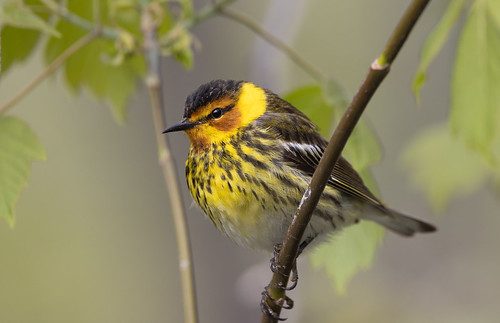 |
| This Cape May Warbler's song is as pretty as he is, but I can't hear it anymore. |
(This is very last-minute before I leave for Alaska in 20 minutes, so hardly any photos!)
I start out every morning drinking a cup of coffee where I can hear birds singing. When it’s cold or raining, I head up to my home office and turn on one of the bird recordings I made this spring. I’ve got a good hundred hours of morning song sound files to go through and edit. It’s a pretty task that takes only half my brain, so I catch up on email and other busy work at the same time.
I’ve been using Adobe Audition to edit my sound files since I was working at the Cornell Lab of Ornithology and got to use all the Adobe products free on my university computer. Some less expensive sound editing programs may be equally good. Virtually all of them allow you to see both the waveform, which shows volume, and the spectrograph, which shows frequency.
My “sound studio” for recording my voice for this podcast is a 2’ cube with one side open and the other five sides covered in soundproofing foam, so there is no background noise to edit out. When I’m editing my own narration, I just use the waveform, which shows me exactly where I need to cut out coughs, sniffling, throat-clearing noises, and mistakes where I did a retake.
It's when I’m editing bird recordings that I need the spectrograph. Visitors often tell me how quiet my neighborhood is, which I used to think, too—at least in the early morning before lawn mowers and chain saws kick in—but when you listen to a recording, you notice the ambient noise. Most of us learn to filter out distant traffic and nearby cars, a gas furnace kicking in, the garbage truck, airplanes, and other human-produced sounds as we go through our daily lives, but these noises stand out when I’m listening with headphones.
These sounds are almost all low-frequency, and the lowest ones, below 400 Hz or so, are both the loudest and the ones that virtually never overlap with bird sounds—at least not in my neighborhood—so I delete them entirely. It’s the frequencies between 400 and about 1.5 kHz that are the problem—those include Mourning Dove songs, geese flying over, and the lowest elements of crow and Blue Jay calls. I can’t delete those frequencies, but I do lower the volume, tweaking it trying to get the birds to sound right without distracting noise.
The computer I use for this is slow, so these preliminary tasks can take a half hour for a long stereo recording, but then comes the fun part—I get to listen to it. I wear high quality earphones or ear pods and list all the birds I hear as I’m going along. I easily identify the vast majority of them, and when I hear something really good—a perfect robin song or a less-than-perfect song of a hard-to-get species—I may copy that segment for a new, short sound file. Listening to these recordings is a lot of fun for me.
When I’m done, I give my ears a break and scroll through the entire file looking, not listening, for just the high frequencies. That’s when my eyes pick out what my ears missed.
This spring, a host of Cape May and Tennessee Warblers visited my feeders and also sang in my yard. Tennessee Warbler notes span a lot of frequencies, so even if I can’t hear the highest elements of their songs, I can still identify them. But Cape May Warbler notes are clear, single tones mostly between 8 and 10 kilohertz. I used to have no trouble at all hearing them, but now, even with my hearing aids cranked up to 11, I can’t hear them at all.
For the past few years, when I’ve been mystified by notes I could see on the spectrograph but couldn’t hear, I’d send a sound clip to one of my young birding friends, but I hated imposing on them. But now the Cornell Lab of Ornithology has developed a great new app called Merlin, giving me the identifications of those high-pitched singers instantly. All Merlin needs to know is the date and location to identify bird sounds outside in real time or when I’m playing a recording. And it’s absolutely free.
Merlin does make mistakes now and then, but shockingly few, and I have enough experience and knowledge of birds moving through Duluth to figure out most of them. I haven’t used Merlin in unfamiliar places yet, but when I do, I’ll be careful to double-check any rarities. It’s an excellent resource, and based on what I’ve heard from both serious, experienced birders and beginners, other users are as thrilled with it as I am.